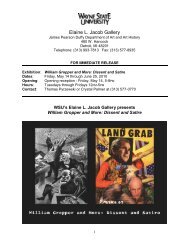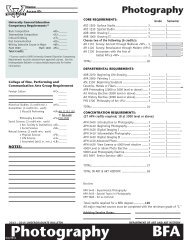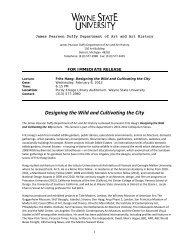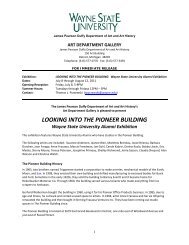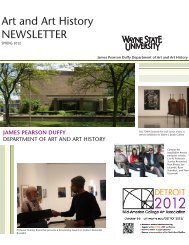linked - Department of Art and Art History - Wayne State University
linked - Department of Art and Art History - Wayne State University
linked - Department of Art and Art History - Wayne State University
Create successful ePaper yourself
Turn your PDF publications into a flip-book with our unique Google optimized e-Paper software.
How Detroit Built My Aesthetic<br />
Thursday, October 4, 1:15 PM – 2:45 PM<br />
Founders B, Level Three, Westin Book Cadillac Hotel<br />
Chair: Christopher S. Olszewski, Savannah College <strong>of</strong> <strong>Art</strong> <strong>and</strong> Design<br />
My upbringing in Detroit, Michigan has played a significant role in my creative process <strong>and</strong> work<br />
ethic. In my drawings, paintings <strong>and</strong> installation projects, the Detroit Aesthetic is always present. My<br />
work is a visual recording <strong>of</strong> my origins <strong>and</strong> the consequential layering <strong>of</strong> my life experiences. I use the<br />
Jeep Gr<strong>and</strong> Cherokee (built in Detroit) as a theme <strong>and</strong> it bridges my exile to the Deep South with my<br />
childhood memories in a once glorious industrial giant.<br />
Detroit is a unique city with a rich <strong>and</strong> complicated history that dominated the 20 th century.<br />
Currently, the city is a platform <strong>of</strong> conversations in 21 st century urban design, urban renewal,<br />
sustainability, contemporary art <strong>and</strong> music. As a Detroit visual artist, I have lived several years<br />
outside the state <strong>of</strong> Michigan <strong>and</strong> I maintain a close connection with the city.<br />
Panel members are studio artists, designers, scholars <strong>and</strong> educators with ties to Detroit. Their<br />
presentations address how Detroit developed, challenged, enhanced or exp<strong>and</strong>ed their aesthetic; how<br />
the city manifested itself into studio/scholarly processes; the role that the city plays in their current<br />
creative practices.<br />
“Fight or Flight: A Detroiter’s Aesthetic”<br />
Melissa V<strong>and</strong>enberg, Eastern Kentucky <strong>University</strong><br />
“Evidence”<br />
Deborah Sukenic, Chicago Public Schools<br />
“Intimate Distance: Negotiating the Urban/Suburban Divide”<br />
Whitney L. Sage, Recent MFA Graduate/Independent Scholar<br />
Between the Literary <strong>and</strong> the Visual: Inter-<strong>Art</strong>istic Approaches to African-American <strong>Art</strong><br />
<strong>History</strong><br />
Thursday, October 4, 1:15 PM – 2:45 PM<br />
Woodward A, Level Two, Westin Book Cadillac Hotel<br />
Chair: Jennifer J. Marshall, <strong>University</strong> <strong>of</strong> Minnesota – Twin Cities<br />
A stubborn truism vexes African-American art history: the canon <strong>of</strong> black American literature is<br />
viewed as more established <strong>and</strong> robust than that <strong>of</strong> black American visual arts. This misconception<br />
has more to do with conventional disciplinary divisions, than it does with either the quantity or<br />
quality <strong>of</strong> black visual expression. Segregating the "literary" from the "visual"--<strong>and</strong> assigning these to<br />
English <strong>and</strong> <strong>Art</strong> <strong>History</strong> departments, respectively--has obscured the originally inter-artistic nature <strong>of</strong><br />
much black cultural expression as well as the terms <strong>of</strong> its early reception <strong>and</strong> critique.




